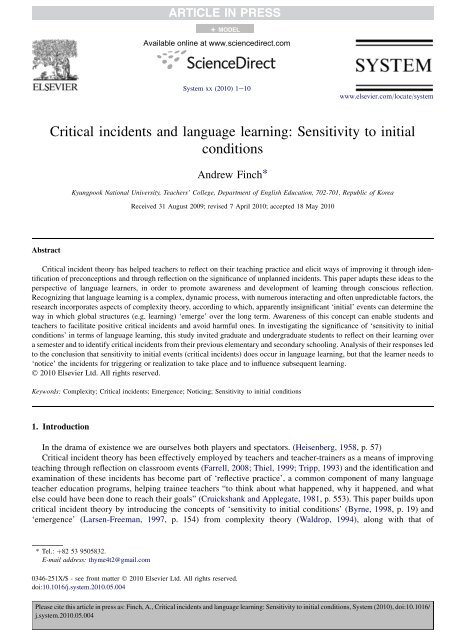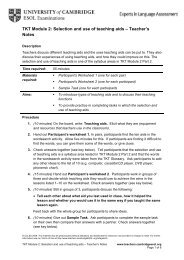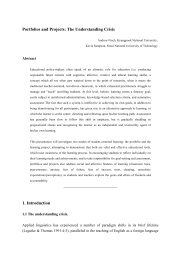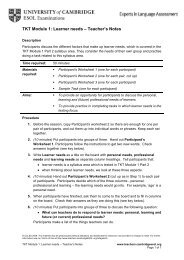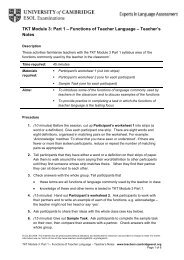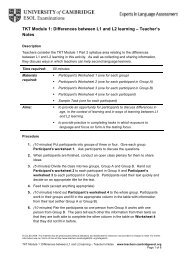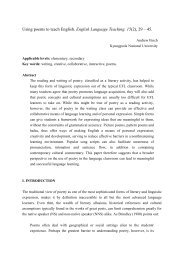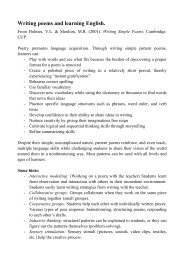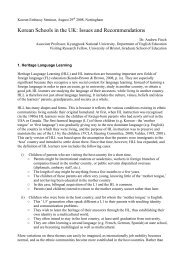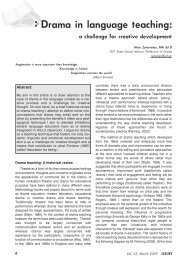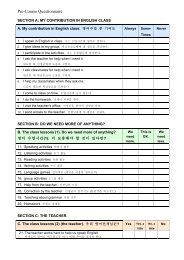Critical incidents and language learning: Sensitivity ... - Finchpark.com
Critical incidents and language learning: Sensitivity ... - Finchpark.com
Critical incidents and language learning: Sensitivity ... - Finchpark.com
Create successful ePaper yourself
Turn your PDF publications into a flip-book with our unique Google optimized e-Paper software.
Abstract<br />
<strong>Critical</strong> <strong>incidents</strong> <strong>and</strong> <strong>language</strong> <strong>learning</strong>: <strong>Sensitivity</strong> to initial<br />
conditions<br />
Andrew Finch*<br />
Kyungpook National University, Teachers’ College, Department of English Education, 702-701, Republic of Korea<br />
Received 31 August 2009; revised 7 April 2010; accepted 18 May 2010<br />
<strong>Critical</strong> incident theory has helped teachers to reflect on their teaching practice <strong>and</strong> elicit ways of improving it through identification<br />
of preconceptions <strong>and</strong> through reflection on the significance of unplanned <strong>incidents</strong>. This paper adapts these ideas to the<br />
perspective of <strong>language</strong> learners, in order to promote awareness <strong>and</strong> development of <strong>learning</strong> through conscious reflection.<br />
Recognizing that <strong>language</strong> <strong>learning</strong> is a <strong>com</strong>plex, dynamic process, with numerous interacting <strong>and</strong> often unpredictable factors, the<br />
research incorporates aspects of <strong>com</strong>plexity theory, according to which, apparently insignificant ‘initial’ events can determine the<br />
way in which global structures (e.g. <strong>learning</strong>) ‘emerge’ over the long term. Awareness of this concept can enable students <strong>and</strong><br />
teachers to facilitate positive critical <strong>incidents</strong> <strong>and</strong> avoid harmful ones. In investigating the significance of ‘sensitivity to initial<br />
conditions’ in terms of <strong>language</strong> <strong>learning</strong>, this study invited graduate <strong>and</strong> undergraduate students to reflect on their <strong>learning</strong> over<br />
a semester <strong>and</strong> to identify critical <strong>incidents</strong> from their previous elementary <strong>and</strong> secondary schooling. Analysis of their responses led<br />
to the conclusion that sensitivity to initial events (critical <strong>incidents</strong>) does occur in <strong>language</strong> <strong>learning</strong>, but that the learner needs to<br />
‘notice’ the <strong>incidents</strong> for triggering or realization to take place <strong>and</strong> to influence subsequent <strong>learning</strong>.<br />
Ó 2010 Elsevier Ltd. All rights reserved.<br />
Keywords: Complexity; <strong>Critical</strong> <strong>incidents</strong>; Emergence; Noticing; <strong>Sensitivity</strong> to initial conditions<br />
1. Introduction<br />
In the drama of existence we are ourselves both players <strong>and</strong> spectators. (Heisenberg, 1958, p. 57)<br />
<strong>Critical</strong> incident theory has been effectively employed by teachers <strong>and</strong> teacher-trainers as a means of improving<br />
teaching through reflection on classroom events (Farrell, 2008; Thiel, 1999; Tripp, 1993) <strong>and</strong> the identification <strong>and</strong><br />
examination of these <strong>incidents</strong> has be<strong>com</strong>e part of ‘reflective practice’, a <strong>com</strong>mon <strong>com</strong>ponent of many <strong>language</strong><br />
teacher education programs, helping trainee teachers “to think about what happened, why it happened, <strong>and</strong> what<br />
else could have been done to reach their goals” (Cruickshank <strong>and</strong> Applegate, 1981, p. 553). This paper builds upon<br />
critical incident theory by introducing the concepts of ‘sensitivity to initial conditions’ (Byrne, 1998, p. 19) <strong>and</strong><br />
‘emergence’ (Larsen-Freeman, 1997, p. 154) from <strong>com</strong>plexity theory (Waldrop, 1994), along with that of<br />
* Tel.: þ82 53 9505832.<br />
E-mail address: thyme4t2@gmail.<strong>com</strong><br />
+ MODEL<br />
Available online at www.sciencedirect.<strong>com</strong><br />
System xx (2010) 1e10<br />
0346-251X/$ - see front matter Ó 2010 Elsevier Ltd. All rights reserved.<br />
doi:10.1016/j.system.2010.05.004<br />
www.elsevier.<strong>com</strong>/locate/system<br />
Please cite this article in press as: Finch, A., <strong>Critical</strong> <strong>incidents</strong> <strong>and</strong> <strong>language</strong> <strong>learning</strong>: <strong>Sensitivity</strong> to initial conditions, System (2010), doi:10.1016/<br />
j.system.2010.05.004
+ MODEL<br />
2 A. Finch / System xx (2010) 1e10<br />
‘noticing’ (Robinson, 2006; Schmidt, 1995; Truscott, 1998). The investigation into critical events is carried out in<br />
this study from the point of view of the student, rather than the teacher, with the aim of promoting student<br />
autonomy, <strong>learning</strong> strategies <strong>and</strong> responsibility for <strong>learning</strong>. This student-centered view of the <strong>learning</strong> process<br />
<strong>and</strong> the <strong>learning</strong> environment views critical events, ideas <strong>and</strong> ‘aha moments’ (Koestler, 1967) from the learner’s<br />
perspective, identifying the types of <strong>incidents</strong> that students find critical, <strong>and</strong> examining how these influence their<br />
<strong>learning</strong> development.<br />
2. <strong>Critical</strong> incident theory<br />
Farrell (2008) states that, “A critical incident is any unplanned event that occurs during class. [.] if trainee<br />
teachers formally reflect on these critical <strong>incidents</strong>, it may be possible for them to uncover new underst<strong>and</strong>ings of the<br />
teaching <strong>and</strong> <strong>learning</strong> process.” (p. 3). Brookfield (1990) adds ‘perception’ as a defining factor, seeing a critical<br />
incident as any “vividly remembered event which is unplanned <strong>and</strong> unanticipated” (p. 84), while Richards <strong>and</strong> Farrell<br />
(2005) state that such an event should “trigger insights about teaching <strong>and</strong> <strong>learning</strong>” (p. 113). Tripp (1993) takes<br />
a more “interpretative” approach. Acknowledging that “normal, everyday events” (p. 40) can be made critical, he<br />
emphasizes that they are not intrinsically so: “The point is that <strong>incidents</strong> only be<strong>com</strong>e critical because someone sees<br />
them as such” (p. 27). A critical incident (or event) is therefore not only an occurrence that has significant potential for<br />
influencing major change, but it is also perceived as such by the observer/participant. Such perceptions are important<br />
in <strong>language</strong> <strong>learning</strong>, since “learners hold their beliefs to be true <strong>and</strong> these beliefs then guide how they interpret their<br />
experiences <strong>and</strong> how they behave” (Griffiths, 2008, p. 121; cf. Farrell, 2009, p. 221). Because of this, critical events<br />
cannot be objectively identified, measured, or predicted, but are dependent on the awareness <strong>and</strong> willingness-toobserve<br />
of the observer.<br />
<strong>Critical</strong> <strong>incidents</strong> are produced by the way we look at a situation: a critical incident is an interpretation of the<br />
significance of an event. (Tripp, 1993, p.8)<br />
The perception of any incident is, therefore, responsible for the significance ascribed to it <strong>and</strong> this significance<br />
varies from observer to observer. Thus, the ‘critical’ occurrence is the ‘noticing’, which Schmidt (1995, p. 29) refers as<br />
“the conscious registration of the occurrence of some event” (p. 29). Koestler (1967) places such moments in a ‘haha’<br />
(humorous), ‘aha’ (scientific), <strong>and</strong> ‘ah’ (artistic) trilogy of creation: “Gestalt psychologists have coined a word for that<br />
moment of truth, the flash of illumination, when bits of the puzzle suddenly click into place e they call it the AHA<br />
experience” (p. 185). Whatever the prior knowledge, expectancies <strong>and</strong> experiences which set off these moments,<br />
awareness of their existence can help learners to reflect on what are often seemingly minor occurrences, just as trainee<br />
teachers can be taught to “analyse critical <strong>incidents</strong> that occur while they are teaching” (Brennon <strong>and</strong> Green, 1993;<br />
Farrell, 2004 cited by Farrell, 2008, p.3). Such encouragement can be explicit <strong>and</strong> formal (Richards <strong>and</strong> Farrell, 2005;<br />
Thiel, 1999; Tripp, 1993), or implicit in the lesson materials (Finch, 2004a). In this way, <strong>language</strong> learners can be<br />
encouraged to discover “new underst<strong>and</strong>ings” about the <strong>learning</strong> process (Richards <strong>and</strong> Farrell, 2005), providing an<br />
additional dimension to the practice of reflection (Farrell, 2004, 2007, 2009). This focus is referred to by Tripp (1993)<br />
as “the original historical sense of the term, because it could mark an important change or turning point in this learner’s<br />
biography” (p. 9). <strong>Critical</strong> <strong>incidents</strong> can therefore include events or realizations that occur outside the classroom,<br />
either as delayed reactions to lesson content, or as flashes of awareness that arrive in unexpected situations <strong>and</strong><br />
locations, as a consequence of, or triggered by the <strong>learning</strong> process.<br />
3. Chaos, <strong>com</strong>plexity <strong>and</strong> <strong>language</strong> <strong>learning</strong><br />
It seems that the tide of <strong>com</strong>plexity is lapping at our feet as applied linguists, making it timely to consider how<br />
the assumptions <strong>and</strong> perspectives of our own field may be challenged by <strong>com</strong>plexity. (Larsen-Freeman <strong>and</strong><br />
Cameron, 2008, p.5)<br />
One of the major tenets of <strong>com</strong>plexity theory is that it is “a science of process rather than state, of be<strong>com</strong>ing rather<br />
than being” (Gleick, 1987, p. 5), offering an “alternative to the linear, reductionist thinking that has dominated science<br />
since Newton” (Larsen-Freeman, 1997, p. 142) <strong>and</strong> has been responsible for the “assumption that by studying<br />
influences on the process in a piecemeal fashion, <strong>and</strong> then aggregating the findings, we would be able to explain the<br />
Please cite this article in press as: Finch, A., <strong>Critical</strong> <strong>incidents</strong> <strong>and</strong> <strong>language</strong> <strong>learning</strong>: <strong>Sensitivity</strong> to initial conditions, System (2010), doi:10.1016/<br />
j.system.2010.05.004
whole” (Larsen-Freeman, 2007, p. 35). Van Lier (1996) suggests that “it is useful to regard the classroom as a <strong>com</strong>plex<br />
adaptive system” (p. 38) in which “details are all that matters” (Gould, 1993) <strong>and</strong> that “it is fruitless to search for<br />
causal relations” (Van Lier, 1996, p. 38). Larsen-Freeman (1997) sees “many striking similarities between the science<br />
of chaos/<strong>com</strong>plexity <strong>and</strong> second <strong>language</strong> acquisition” (p. 141), pointing out that “<strong>language</strong>s go through periods of<br />
chaos <strong>and</strong> order as do other living systems. Furthermore, their creative growth occurs at the border between these two”<br />
(p. 158). Complexity occurs at this border between order <strong>and</strong> chaos, <strong>and</strong> has been termed ‘the edge of chaos’ by<br />
Waldrop (1994, p. 198), when describing the capacity for <strong>learning</strong> that <strong>com</strong>plex adaptive systems have when they are<br />
neither settled nor chaotic.<br />
Eve et al. (1997), when discussing chaos in relation to the social sciences, describe three characteristics of chaotic<br />
systems:<br />
. there must be a non-linear operation; it must be iteratively carried out, that is, the operation is repeated with<br />
the output of one iterative cycle be<strong>com</strong>ing the input of the next; <strong>and</strong> there must be sensitivity to initial<br />
conditions. (Eve et al., 1997, p. 144)<br />
Language acquisition can be said to be a ‘chaotic’ process, in that it satisfies these three conditions. Firstly, “the<br />
processes involved in behavioral <strong>and</strong> social situations are non-linear” (Eve et al., 1997, p. 145; c.f. Larsen-Freeman,<br />
1997, p. 152). Secondly, <strong>language</strong> lessons are iterative, in that the <strong>learning</strong> out<strong>com</strong>e of one lesson often be<strong>com</strong>es<br />
part of the input of the next, in a modified iterative cycle. Finally, this paper proposes that ‘sensitivity to initial<br />
conditions’ is also a characteristic of <strong>language</strong> <strong>learning</strong>. Known to many as the ‘butterfly effect,’ the concept of<br />
‘sensitivity to initial conditions’ proposes that minor, (often unmeasurable) changes at the starting point of a process<br />
can produce startlingly different <strong>and</strong> unpredictable results: “A small perturbation in a system will produce very large<br />
changes in the results over time” (Eve et al., 1997, p 145). This concept is applied in this paper to the analysis of<br />
critical <strong>incidents</strong>, by proposing those events that seem insignificant when they occur can grow to have major<br />
implications in terms of the ‘emergence’ of effective <strong>learning</strong>. This latter term (‘emergence’) is another concept<br />
from <strong>com</strong>plexity theory, describing the way in which global events <strong>and</strong> processes grow from the interactions of<br />
local ‘connectivities’ or systems. If we consider a tree, for example, we can view it as consisting of various<br />
subsystems (branches, leaves, bark, roots), which, as they interact with each other (<strong>and</strong> with other systems such as<br />
the weather, birds, insects <strong>and</strong> surrounding trees), produce growth. It is not possible to predict how cells will form or<br />
<strong>com</strong>bine, but what can be said is that a structure will emerge that is typical of that species of tree (Finch, 2004b). If<br />
we look at the awareness of critical events as individual cells in this analogy, then the emergence of <strong>learning</strong> is<br />
sensitive to these initial conditions <strong>and</strong> dependent upon the way in which they interact with the <strong>learning</strong><br />
environment.<br />
Eve et al. (1997) point out that chaos is not ‘chaotic’ in the normal meaning of the term, but has observable<br />
properties such as ‘attractors,’ ‘self-organization,’ <strong>and</strong> ‘emergence’ (pp. 21, 22, 34) <strong>and</strong> “can lead to order <strong>and</strong> indeed<br />
to a form of stability that gives us an improved ability to forecast <strong>and</strong> even control the future. [.] Chaos is first <strong>and</strong><br />
foremost deterministic, <strong>and</strong> it is this determinism that is illuminating, not indeterminacy” (p. 144). Complexity, being<br />
‘life at the edge of chaos’ (Lewin, 2000), also possesses these qualities <strong>and</strong> offers “a more en<strong>com</strong>passing, balanced, yet<br />
detailed-oriented, perspective” (Larsen-Freeman, 2007, p. 35), allowing us to view second <strong>language</strong> acquisition as<br />
a dynamic, <strong>com</strong>plex, non-linear process that is open, self-organizing, adaptive, unpredictable, <strong>and</strong> sensitive to initial<br />
conditions (Byrne, 1998, p. 19).<br />
The educational context, with the classroom at its center, is viewed as a <strong>com</strong>plex system in which events do<br />
not occur in linear causal fashion, but in which a multitude of forces interact in <strong>com</strong>plex, self-organizing<br />
ways, <strong>and</strong> create changes <strong>and</strong> patterns that are part predictable, part unpredictable. (Van Lier, 1996, p.148)<br />
4. The study<br />
+ MODEL<br />
A. Finch / System xx (2010) 1e10<br />
Three instruments were used in this study, which took place in the English Education Department of a University in<br />
Korea. These instruments, which were used in three credit courses, consisted of a <strong>learning</strong> journal, an online survey<br />
about student <strong>learning</strong> experiences during the semester, <strong>and</strong> another online survey about critical events in elementary<br />
or secondary schooling. The medium of instruction in the university credit courses was English <strong>and</strong> the lessons took<br />
the form of blended <strong>learning</strong>, using lectures, online course software, <strong>and</strong> workshop-style group projects. 44 undergraduate<br />
<strong>and</strong> 30 graduate students were invited to participate.<br />
Please cite this article in press as: Finch, A., <strong>Critical</strong> <strong>incidents</strong> <strong>and</strong> <strong>language</strong> <strong>learning</strong>: <strong>Sensitivity</strong> to initial conditions, System (2010), doi:10.1016/<br />
j.system.2010.05.004<br />
3
4.1. Learning journal<br />
The <strong>learning</strong> journal 1 (Finch, 2004a) consisted of 15 sets of group activities focusing on educational issues, using<br />
adapted questionnaires from published research (e.g. CEQ, CLE, FCLAS, LIS, MIS, SILL), along with surveys <strong>and</strong><br />
interviews. Each set of activities was followed by individual, written reflection on those issues or on anything else that<br />
the students perceived as meaningful. Rather than instructing students on methods of identifying <strong>and</strong> classifying<br />
significant events, this approach offered the opportunity to investigate <strong>learning</strong> <strong>and</strong> the <strong>learning</strong> environment on<br />
a continuous basis, thus raising awareness of the <strong>learning</strong> process. All meta-cognition <strong>and</strong> consciousness-raising was<br />
implicit in the group activities, rather than explicitly taught. In this way, it was hoped to promote spontaneous <strong>and</strong><br />
original responses.<br />
Forty-four graduate students taking a credit course in the Department of English Education were asked to reflect on<br />
their <strong>learning</strong> (<strong>and</strong> on <strong>learning</strong> in general) over the course of a semester, using the <strong>learning</strong> journal. In addition to this<br />
reflective function <strong>and</strong> to the development of writing skills which the journal promoted, it also served as context <strong>and</strong><br />
consciousness-raising preparation for the end-of-semester surveys, which invited students to identify <strong>and</strong> <strong>com</strong>ment on<br />
their interpretations of critical events that had occurred during the semester <strong>and</strong> during their previous schooling. It was<br />
not in the nature of the journal to identify critical events. Rather it was intended that students would be<strong>com</strong>e aware of<br />
<strong>and</strong> review their beliefs, opinions <strong>and</strong> perceptions regarding <strong>language</strong> <strong>learning</strong> <strong>and</strong> teaching <strong>and</strong> that during this<br />
process, they would begin to look back for the origin of their beliefs, being ready to ‘notice’ any critical events that<br />
they perceived as particularly significant in the emergence of their attitudes to <strong>learning</strong>.<br />
4.2. Survey 1: ‘critical <strong>incidents</strong>’<br />
+ MODEL<br />
4 A. Finch / System xx (2010) 1e10<br />
In the first survey used in this research, 44 undergraduate <strong>and</strong> 30 graduate students were asked to reflect on<br />
events (academic, emotional, interactional, social, <strong>and</strong> affective) which occurred during the academic semester<br />
<strong>and</strong> which they felt had significance for their future progress. This survey is part of the free Moodle course software<br />
(www.moodle.<strong>com</strong>), which was used in this study to make course information, resources <strong>and</strong> assignments available to<br />
students online 2 , as part of a blended <strong>learning</strong> approach. The survey contains the following five questions:<br />
1 At what moment in class were you most engaged as a learner?<br />
2 At what moment in class were you most distanced as a learner?<br />
3 What action from anyone in the forums did you find most affirming or helpful?<br />
4 What action from anyone in the forums did you find most puzzling or confusing?<br />
5 What event surprised you most?<br />
Responses were classified according to observable trends <strong>and</strong> categories, indicating types of events that students<br />
considered significant.<br />
4.2.1. Question 1: At what moment in class were you most engaged as a learner?<br />
Responses to this question, which investigates how students related with the <strong>learning</strong> environment, can be broadly<br />
categorized according to the following topics: i) presentations (n ¼ 13); ii) activities (n ¼ 11); iii) discussions<br />
(n ¼ 10); iv) assignments (n ¼ 7); <strong>and</strong> v) groups (n ¼ 3). While only three students thought that group-<strong>learning</strong><br />
facilitated concentration, a larger number qualified this to include the first category (group presentations), the<br />
collaboration which took place because of them, <strong>and</strong> the benefits they gained from watching the presentations of other<br />
groups.<br />
. the moment I am [sic] 3 engaged most, I think it was the short presentation, Our team members were really<br />
trying to be good. We had several times of meeting to <strong>com</strong>plete the task <strong>and</strong> edit the whole materials.. Yes, it<br />
was really good. (Student 16, June 2009)<br />
1 This journal can be viewed online at: www.finchpark.<strong>com</strong>/books/lj/index2.htm.<br />
2 These resources can be viewed at: www.finchpark.<strong>com</strong>/moodle/.<br />
3 From this point, responses are presented ‘as is’, without <strong>com</strong>ments on grammaticality.<br />
Please cite this article in press as: Finch, A., <strong>Critical</strong> <strong>incidents</strong> <strong>and</strong> <strong>language</strong> <strong>learning</strong>: <strong>Sensitivity</strong> to initial conditions, System (2010), doi:10.1016/<br />
j.system.2010.05.004
+ MODEL<br />
A. Finch / System xx (2010) 1e10<br />
Other students identified the act of having discussions about tasks <strong>and</strong> assignments as meaningful <strong>and</strong> engaging.<br />
I was most engaged as a learner when I had a discussion with other students over one topic in class.<br />
(Student 31, June 2009)<br />
Classroom activities were also identified as meaningful <strong>and</strong> engaging.<br />
During the activities, I felt that I was a learner. I was happy, <strong>and</strong> I can learn from other students by interacting.<br />
(Student 4, June 2009)<br />
4.2.2. Question 2: At what moment in class were you most distanced as a learner?<br />
This question raises the possibility that certain critical <strong>incidents</strong> might be<strong>com</strong>e negative initial conditions,<br />
eventually emerging as obstacles to <strong>learning</strong>. The main categories of response were: i) perceived weaknesses<br />
(n ¼ 14); ii) presentations (n ¼ 10); iii) failure to <strong>com</strong>municate (n ¼ 9); <strong>and</strong> iv) listening to the teacher (n ¼ 6).<br />
A further group (n ¼ 10) indicated that they did not feel distanced. Perceived weaknesses formed the largest group<br />
for this question, suggesting that Korean students, perhaps due to traditional <strong>language</strong>-as-code teaching methods<br />
(grammar-translation, etc.), often have unrealistic <strong>learning</strong> expectations, seeing themselves as poor learners unless<br />
they have acquired the whole of the target <strong>language</strong>. However, a number of students saw these weaknesses as reasons<br />
for working harder.<br />
Owing to lack of my knowledge., I sometimes couldn’t underst<strong>and</strong> what [the teacher] <strong>and</strong> other students<br />
said. I was sorry about that, rather, it encouraged <strong>and</strong> stimulated me to learn <strong>and</strong> study. (Student 21, June 2009)<br />
Interestingly, the group presentations, which were identified as engaging in question 1, were also sources of<br />
distancing in this second question, largely because of poor preparation <strong>and</strong> presentation skills on the part of peers.<br />
I would say the moment when I am listening to a group’s presentation. It was because they were not prepared<br />
well. (Student 12, June 2009)<br />
Failure to <strong>com</strong>municate might be seen as an extension of the first group of responses (perceived weaknesses), in<br />
terms of <strong>com</strong>munication <strong>and</strong> interaction.<br />
Actually, I did not speak English when I was with some familiar friends. This course is the only class that<br />
gives an opportunity to talk English to me. I appreciated the chance, but lost it sometimes. (Student 6,<br />
June 2009)<br />
4.2.3. Question 3: What action from anyone in the forums did you find most affirming or helpful?<br />
Returning to a positive focus, the main categories of response to this question were: i) cooperation (n ¼ 14); ii)<br />
useful peer/teacher feedback (n ¼ 11); iii) peer examples (role models) (n ¼ 7); iv) positive attitudes (n ¼ 6); <strong>and</strong> v)<br />
constructive feedback (n ¼ 3). Cooperation <strong>and</strong> collaboration were given emphasis in the group-oriented <strong>and</strong> taskbased<br />
<strong>learning</strong> environment of the course, <strong>and</strong> this was identified as a significant feature. The responses in this<br />
category are particularly interesting when the initial condition of friendly cooperation is seen as leading to the<br />
emergence of positive <strong>learning</strong> experiences <strong>and</strong> attitudes.<br />
When I asked a classmate for help to teach me a skill, the person kindly offered me help. (Student 48,<br />
June 2009)<br />
Allied to this issue of cooperation were the next three categories (in order of number of responses), ‘useful<br />
information from peers <strong>and</strong> the teacher,’ ‘peer examples’ <strong>and</strong> ‘positive attitudes.’ It was apparently significant for the<br />
students that they were helping each other with information as well as skills, <strong>and</strong> those certain peers were providing<br />
positive input (initial conditions) as role models.<br />
The positive attitude of people inspired <strong>and</strong> motivated me. It was very helpful to do everything hard.<br />
(Student 3, June 2009)<br />
In every class, some people started to speak in English as soon as they came in the classroom. Thanks to them,<br />
most of the students [were] encouraged to speak in English. That was quite helpful. (Student 17, June 2009)<br />
Please cite this article in press as: Finch, A., <strong>Critical</strong> <strong>incidents</strong> <strong>and</strong> <strong>language</strong> <strong>learning</strong>: <strong>Sensitivity</strong> to initial conditions, System (2010), doi:10.1016/<br />
j.system.2010.05.004<br />
5
+ MODEL<br />
6 A. Finch / System xx (2010) 1e10<br />
4.2.4. Question 4: What action from anyone in the forums did you find most puzzling or confusing?<br />
This question examines aspects that challenged students in terms of <strong>com</strong>prehension or rationale. Interestingly, the<br />
main category of response for this question was ‘none’ (n ¼ 21). Other categories included: i) peer-problems <strong>and</strong> lack<br />
of <strong>com</strong>mitment (n ¼ 15); ii) misunderst<strong>and</strong>ings (n ¼ 5); iii) group problems (n ¼ 2); <strong>and</strong> iv) lack of punctuality<br />
(n ¼ 3). It is interesting here that the proactive cooperation <strong>and</strong> the positive view of presentations instanced in<br />
responses to questions 1 <strong>and</strong> 3 exist alongside problems in the same areas.<br />
I found groundless praise <strong>and</strong> encouragement not just puzzling <strong>and</strong> confusing, but irritating as well. Those<br />
bl<strong>and</strong> praises often imply that they did not pay much attention to my work after all. (Student 2, June 2009)<br />
4.2.5. Question 5: What event surprised you most?<br />
The act of identifying an event as ‘surprising’ increases the chances of it be<strong>com</strong>ing a critical incident (initial<br />
condition) from which positive <strong>learning</strong> attitudes might emerge. Categories of response included: i) course events<br />
(n ¼ 11); ii) other students’ work (n ¼ 10); iii) personal achievement (n ¼ 8); iv) class activity (n ¼ 7); v) attitude<br />
change (n ¼ 7); <strong>and</strong> vi) nothing (n ¼ 5). The first group (‘course events’) concerns students’ expectations <strong>and</strong> their<br />
surprise when these were challenged.<br />
At first, I am surprised with the style of this course. It is totally student-centered lesson. Because I’m<br />
accustomed to the traditional teaching method, I like to learn in a different environment. (Student 23,<br />
June 2009)<br />
The second <strong>and</strong> third groups (‘other students’ work’ <strong>and</strong> ‘personal achievement’) indicate positive <strong>learning</strong><br />
experiences in terms of peer-work <strong>and</strong> individual work.<br />
The group presentation. It was amazing. Many groups were cooperating <strong>and</strong> showed great presentations.<br />
They look having great ability <strong>and</strong> potential. (Student 6, June 2009)<br />
The impact of class activities has already been mentioned in responses to question 1. Of particular interest to the<br />
researcher in the responses to question 5 was an indication that positive attitude change was occurring.<br />
Writing the journal. I realized doing something regularly is really important to be good at something. I feel my<br />
attitude has changed that way. (Student 14, June 2009)<br />
I’m used to follow <strong>com</strong>petition society, but through the course, I have changed my thinking about collaboration<br />
<strong>and</strong> <strong>com</strong>petition. I have started to believe that positive effects of collaboration. I think it is most<br />
important to me. (Student 27, June 2009)<br />
Looking at the responses to the five questions in the ‘critical events’ survey, it can be seen that an interactive, taskbased,<br />
workshop environment allowed students to collaborate, to explore relationships <strong>and</strong> assignments together, to<br />
appreciate each others’ efforts, <strong>and</strong> to reflect on their <strong>learning</strong> experiences. The course content was also meta-content,<br />
encouraging students to evaluate the processes that were occurring, with a view to promote heightened awareness <strong>and</strong><br />
subsequent enhancement of <strong>learning</strong>. By focusing on their perceptions in the survey, it was hoped that students would<br />
be<strong>com</strong>e better, more efficient learners, more aware of the factors involved in <strong>learning</strong>, “What we observe is not nature<br />
itself but nature exposed to our method of questioning” (Heisenberg, 1958, p. 57).<br />
A basic concept of sensitivity to initial conditions is that immeasurable differences at the start of a process can have<br />
largely differing repercussions later <strong>and</strong> it was noticeable that students <strong>com</strong>pleting the first survey did not have the<br />
distance to identify potentially seminal events. For this reason, the second survey was given, with the goal of<br />
discovering what sort of events were seen as significant over the long term.<br />
4.3. Survey 2: ‘critical events in school’<br />
This second online survey encouraged students to identify events from earlier schooling, which they now perceived<br />
as significant, thus giving greater depth to the study <strong>and</strong> to the concept of ‘sensitivity to initial conditions’. Question 1<br />
dealt with elementary school, while Questions 2 <strong>and</strong> 3 substituted the words ‘Middle’ (Q2) or ‘High’ (Q3) for<br />
‘Elementary’:<br />
Please cite this article in press as: Finch, A., <strong>Critical</strong> <strong>incidents</strong> <strong>and</strong> <strong>language</strong> <strong>learning</strong>: <strong>Sensitivity</strong> to initial conditions, System (2010), doi:10.1016/<br />
j.system.2010.05.004
+ MODEL<br />
A. Finch / System xx (2010) 1e10<br />
Q1: Can you remember any events when you were a student in Elementary school that changed your attitude to<br />
<strong>learning</strong>? These could be major events, minor events, or even seemingly insignificant events. Maybe these<br />
events occurred because of the teacher, the school, the weather, the subjects, your friends, etc.. What events<br />
st<strong>and</strong> out for you? How did they affect your attitude to <strong>learning</strong>?<br />
Seventy students submitted answers to this survey, <strong>and</strong> their responses, which were analyzed using NVIVO8 data<br />
analysis software, identified a number of types of events or factors which had triggered ‘aha’ moments, or which had<br />
critically influenced them. Most of these categories dealt with “vividly remembered” events (Brookfield, 1990), but<br />
a significant number also identified events which seemed insignificant at the time <strong>and</strong> which gradually assumed<br />
greater importance. Of the possible 210 responses, the 174 “Yes” responses fall into the following main classifications:<br />
1. Teachers: 75 entries<br />
Motivational or new teaching methods: 22 entries<br />
The teacher as a role model: 21 entries<br />
Positive <strong>com</strong>ments <strong>and</strong> praise for the students: 15 entries<br />
Undesirable behavior by the teacher: 12 entries<br />
Strict teachers: 5 entries<br />
2. Personal ideas <strong>and</strong> events: 31 entries<br />
3. Experience of success: 20 entries<br />
4. Family: 16 entries<br />
5. Friends: 11 entries<br />
6. Stress: 8 entries<br />
Most of the critical events concerning teachers were ongoing (rather than one-off) <strong>and</strong> had a lasting effect on the<br />
students. In this case, the noticing that occurred when looking back on previous schooling identified processes <strong>and</strong><br />
long-term situations:<br />
I was a little pessimistic student. However, my homeroom teacher was very kind <strong>and</strong> care[d] about me. I was<br />
moved by her kind words <strong>and</strong> attitude. She changed my attitude to life as well as [to] <strong>learning</strong>. (Student 18 4 ,<br />
December, 2009)<br />
When I was a third grade student, my homeroom teacher was an English teacher. Thanks to her dynamic <strong>and</strong><br />
interesting English classes, I got interested in English. (Student 21, December, 2009)<br />
However, there were also a significant number of individual events, which were identified as generative. Three<br />
samples are offered here:<br />
There was a critical event: 1 day my parents took us to a Zoo in Daegu, where I saw my father talking to<br />
a blond-haired, blue-eyed looking foreigner in English: it was a very curious thing to a little girl. I asked my<br />
father later how he could <strong>com</strong>municate with the foreigner. My father told me that I can do that too if I study<br />
hard. So I did. (Student 1, December 2009)<br />
My father one day asked me, "How will you make your living when you grow up?" I thought to myself, "I<br />
can’t sing well, I don’t look that glamorous, but I am good at studying <strong>and</strong> <strong>learning</strong> new things”. I studied<br />
really hard <strong>and</strong> my grades soared. This, I think, was one of the most critical moments in my life. (Student 44,<br />
December 2009)<br />
One day in 3rd grade in high school, I recognized that I spent most of my 19 years only for studying <strong>and</strong> my<br />
parents devoted their life only for my happ[iness]. (Student 3, December 2009)<br />
In the first of these examples, the event of going to the zoo <strong>and</strong> seeing her father talking with a foreigner sparked<br />
curiosity, which then triggered the will to emulate <strong>and</strong> to achieve. In the second example, noticing is set off by<br />
a parent’s <strong>com</strong>ment, which is seen as a critical incident. In the third example, however, awareness <strong>com</strong>es ‘out of the<br />
4 Student numbers in Survey 2 do not refer to the same students in Survey 1.<br />
Please cite this article in press as: Finch, A., <strong>Critical</strong> <strong>incidents</strong> <strong>and</strong> <strong>language</strong> <strong>learning</strong>: <strong>Sensitivity</strong> to initial conditions, System (2010), doi:10.1016/<br />
j.system.2010.05.004<br />
7
+ MODEL<br />
8 A. Finch / System xx (2010) 1e10<br />
blue’ <strong>and</strong> we are given no hint of any causative factors. This would indeed seem to be an ‘aha’ moment. We can only<br />
speculate on the prior influences, experiences <strong>and</strong> expectations which lay dormant or which were interacting ‘under<br />
the surface’ before emerging at this moment.<br />
These reflections support a sensitivity-to-initial-conditions/noticing/emergence-of-<strong>learning</strong> sequence, as can be<br />
also observed in the effects of isolated <strong>com</strong>ments made by teachers:<br />
When I did not [do] good on my exam, my home teacher left me a message on my diary. It said, test is nothing<br />
to worry about <strong>and</strong> you have a whole life ahead of you. After I saw the message, I changed my mind [.],<br />
exam was no longer burdensome to me. (Student 41, December 2009)<br />
1 day my teacher said to me that "I thought you’re better than that." I am 100% sure <strong>and</strong> know that he had no<br />
intention to hurt my feelings or discourage me on purpose. [.]. However, I was seriously hurt by the innocent,<br />
short <strong>com</strong>ment. (Student 49, December 2009)<br />
. my teacher came to me when I was studying <strong>and</strong> told me that I was doing a very good job. . This small<br />
incident actually encouraged me very much, <strong>and</strong> since 3rd grade, my grades really improved. (Student 45,<br />
December 2009 )<br />
Students here identify seemingly unimportant events which can easily be overlooked by teachers, but which can<br />
have disproportionate repercussions, depending on the noticing that occurs. The concept of sensitivity to initial events<br />
confirms that teachers need to beware of making negative <strong>com</strong>ments or of using body <strong>language</strong>, which can be<br />
perceived as derogatory. It also suggests (as with the students who observed continuous positive attitudes in their<br />
teachers) that positive input, however small, can have extremely positive results.<br />
It goes without saying that critical <strong>incidents</strong> can be negative as well as positive in terms of initial conditions <strong>and</strong> that<br />
negative input can lead to negative emergence. Some of the12 entries, which dealt with undesirable practices by<br />
teachers, mention corporal punishment, a practice which has since been banned in Korea. However, others focus on<br />
non-violent <strong>incidents</strong>, which impeded further <strong>learning</strong>:<br />
One boy bothered me almost everyday, so I got stressed <strong>and</strong> even I didn’t want to go to school no longer.<br />
Finally, I decided to tell my teacher but she didn’t do anything, so I was really disappointed about it. After that,<br />
I hardly talked with teachers. (Student 23, December 2009)<br />
. a new teacher came. She was not good at dealing with class management <strong>and</strong> teaching. . I started not to<br />
enjoy studying. She was so partial to the rich students. She didn’t care for all the students. (Student 34,<br />
December 2009)<br />
My homeroom teacher told me that my score was not good enough to go to the university. I wanted to prove<br />
myself <strong>and</strong> to show him that I can do it. So after that, I struggled <strong>and</strong> got an almost perfect score at SAT.<br />
(Student 3, December 2009)<br />
I felt awkward now that I was memorizing words just because of the fear. (Student 29, December 2009)<br />
Apart from the obvious effect of slapping <strong>and</strong> hitting on the part of the teacher, these <strong>and</strong> other similar entries show<br />
students be<strong>com</strong>ing demotivated <strong>and</strong> giving up <strong>learning</strong> because a teacher treats them unfairly, ignores them, or instils<br />
fear in them. One student (above) is successful in disproving the teacher’s negative <strong>com</strong>ment by showing that he/she is<br />
good enough to go to university, but it would be dangerous to justify the <strong>com</strong>ment on these grounds. The number of<br />
students taking such a positive attitude seems likely to be small in proportion to those for whom the <strong>com</strong>ment could do<br />
severe harm in terms of their <strong>learning</strong> paths.<br />
A further factor identified as critical in many of the categories is success. It is significant in these examples that the<br />
experience of success led to further success, as in Brophy’s (2004) <strong>com</strong>ment, “The simplest way to ensure that students<br />
expect success is to ensure that they achieve it consistently 5 ” (p. 66).<br />
[My teacher] let me enter a kind of writing contest. I didn’t expect to win any award so, I just forgot about the<br />
contest. However I’ve got an award <strong>and</strong> a gift a couple of weeks later. I couldn’t believe that. Since then I’ve<br />
5 Italics in the original.<br />
Please cite this article in press as: Finch, A., <strong>Critical</strong> <strong>incidents</strong> <strong>and</strong> <strong>language</strong> <strong>learning</strong>: <strong>Sensitivity</strong> to initial conditions, System (2010), doi:10.1016/<br />
j.system.2010.05.004
liked to read books <strong>and</strong> write about what I read. I really thank her for finding my talent. (Student 11,<br />
December 2009)<br />
When I got prize in writing diary, I was very glad. So till now I’m writing diary, which is very helpful to me.<br />
(Student 30, December 2009)<br />
When I was in Elementary school, nobody told me to study <strong>and</strong> I used to play all day long, then, one day,<br />
I became curious about certain subject (I can’t remember what exactly it was.), so I started to look through<br />
books <strong>and</strong> spent several days reading books. What a surprise!! I got the first prize on the final exam when I was<br />
in sixth grade. From that moment, I came to love studying. (Student 54, December 2009)<br />
While there is insufficient space to analyze the responses to this survey in depth in this paper, it is evident that<br />
events occurred in previous schooling, which the respondents saw as critical <strong>incidents</strong>. These <strong>incidents</strong> were the<br />
starting points (initial conditions) for significant changes in on their subsequent <strong>learning</strong> paths. A number of the<br />
<strong>incidents</strong> were apparently unexpected <strong>and</strong> unpredictable ‘aha’ moments of realization, rather than tiny sparks which<br />
set off a process leading to a forest fire. But if we consider these as sudden instances of emergence, then they can be<br />
seen as tips of icebergs, sitting on top of a mass of previous experiences <strong>and</strong> influence, all of which lead back to the<br />
initial critical <strong>incidents</strong>. Other observations identified critical processes, such as the ongoing positive attitude of<br />
a teacher who is seen as a positive role model. In this case, any one of a number of positive actions could make<br />
a critical impression <strong>and</strong> motivate the student. Finally, there were the negative <strong>incidents</strong>, often unrecognized by the<br />
teacher, which had deleterious results in terms of <strong>learning</strong>.<br />
Results of this second survey confirm Van Lier’s (1996) observation that lasting educational value is often recorded<br />
in affective, rather than logical terms:<br />
It is quite possible that the deepest, most satisfying aspects of achievement, <strong>and</strong> the most profound effects of<br />
education, both in positive <strong>and</strong> negative terms, are entirely unmeasurable . What if we held educators<br />
accountable for the quality of the memories they gave to their students, rather than for averages on national<br />
tests? (p. 120)<br />
5. Conclusion<br />
+ MODEL<br />
A. Finch / System xx (2010) 1e10<br />
Research into the relationship between <strong>com</strong>plexity <strong>and</strong> ELT is still very young, though it promises to throw<br />
important light on <strong>language</strong> <strong>learning</strong> as a <strong>com</strong>plex, adaptive, dynamic, non-linear process (Larsen-Freeman <strong>and</strong><br />
Cameron, 2008, p. 251). This study has attempted to apply the concept of ‘sensitivity to initial conditions’ to<br />
<strong>language</strong> <strong>learning</strong>, while promoting consciousness of this sensitivity <strong>and</strong> awareness of <strong>language</strong> <strong>learning</strong> processes on<br />
the part of the learners. It is inevitable that such a <strong>com</strong>plex process as <strong>language</strong> <strong>learning</strong> will not progress in the same<br />
way, or at the same speed, for different individuals, <strong>and</strong> that acquisition of linguistic specifics (morphology, syntax,<br />
phonology, etc.) cannot be predicted. However, it is also a property of <strong>com</strong>plexity that higher-order structures<br />
(<strong>language</strong> <strong>learning</strong> <strong>and</strong> use) ‘emerge’ out of the initial conditions, to which they are extremely sensitive.<br />
By researching students’ perceptions of events, which they consider to be significant, therefore, <strong>and</strong> by helping<br />
students to be aware of the significance of such events, this research has attempted to chart a path for the emergence of<br />
positive <strong>and</strong> constructive <strong>learning</strong> in the future. As the analogy of the ‘pebble effect’ tells us, if we keep throwing<br />
pebbles down a mountain, there will eventually be an avalanche. We cannot predict which pebble will trigger the<br />
avalanche, but we can keep throwing them until it occurs. Similarly, it is proposed that by offering a stress-free<br />
<strong>learning</strong> environment <strong>and</strong> by being desirable role models, teachers can provide a wealth of positive initial conditions,<br />
any one of which has the potential to be ‘noticed’ at an appropriate time by individual students.<br />
At this stage, this research is just beginning; it will be necessary to follow it up with interviews <strong>and</strong> further surveys<br />
with the participants on a longitudinal basis. However, it is surmised that even the initial awareness-raising that has<br />
occurred due to the attention of students being drawn to the concept of critical events, has, thanks to the ‘observer<br />
effect’ (or ‘Hawthorne effect’) the potential to help those students be<strong>com</strong>e more effective <strong>and</strong> informed learners. Just<br />
as the experimenter’s presence impacts on the results of a study (Marshall, 2005), so it is proposed that this ‘observer<br />
effect’ will transform self-identification of critical events into significant conscious-raising for the learners, opening<br />
the door to further awareness <strong>and</strong> improvement of the <strong>learning</strong> process.<br />
Please cite this article in press as: Finch, A., <strong>Critical</strong> <strong>incidents</strong> <strong>and</strong> <strong>language</strong> <strong>learning</strong>: <strong>Sensitivity</strong> to initial conditions, System (2010), doi:10.1016/<br />
j.system.2010.05.004<br />
9
+ MODEL<br />
10 A. Finch / System xx (2010) 1e10<br />
References<br />
Brennon, M., Green, B., 1993. <strong>Critical</strong> Reflective Writing. Deakin University, Geelong.<br />
Brookfield, S.D., 1990. The Skillful Teacher. Jossey Bass, San Francisco.<br />
Brophy, J.E., 2004. Motivating Students to Learn. Routledge, Mahwah, N.J.<br />
Byrne, D., 1998. Complexity Theory <strong>and</strong> the Social Sciences. Routledge, New York, NY.<br />
Cruickshank, D.R., Applegate, J., 1981. Reflective teaching as a strategy for teacher growth. Educational Leadership 38 (7), 553e554.<br />
Eve, R.A., Horsfall, S., Lee, M.E. (Eds.), 1997. Chaos, Complexity, <strong>and</strong> Sociology: Myths, Models <strong>and</strong> Theories. Sage Publications, Inc., London.<br />
Farrell, T., 2004. Reflective Practice in Action. Corwin Press, Thous<strong>and</strong> Oaks, CA.<br />
Farrell, T., 2007. Reflective Teaching: From Research to Practice. Continuum, New York.<br />
Farrell, T., 2008. <strong>Critical</strong> <strong>incidents</strong> in ELT initial teacher training. ELT Journal 62 (1), 3e10.<br />
Farrell, T., 2009. <strong>Critical</strong> reflection in a TESL course: mapping conceptual change. ELT Journal 63 (3), 221e229.<br />
Finch, A.E., 2004a. English Reflections: An Interactive, Reflective Learner Journal. Daegu. Kyungpook National University Press,<br />
Republic of Korea.<br />
Finch, A.E., 2004b. Complexity <strong>and</strong> systems theory: implications for the EFL teacher/researcher. Journal of Asia TEFL 1 (2), 27e46.<br />
Gleick, J., 1987. Chaos: Making a New Science. Penguin Books, New York.<br />
Gould, S.J., 1993. Eight Little Piggies: Reflection in Natural History. W.W. Norton & Company, New York.<br />
Griffiths, C., 2008. Lessons from Good Language Learners. Cambridge University Press, Cambridge.<br />
Heisenberg, W., 1958. Physics <strong>and</strong> Philosophy. George Allen & Unwin Ltd, London.<br />
Koestler, A., 1967. The Ghost in the Machine. Anchor Press, Tiptree, UK.<br />
Larsen-Freeman, D., 1997. Chaos/<strong>com</strong>plexity science <strong>and</strong> second <strong>language</strong> acquisition. Applied Linguistics 18 (2), 141e165.<br />
Larsen-Freeman, D., 2007. On the <strong>com</strong>plexity of chaos/<strong>com</strong>plexity theory <strong>and</strong> dynamic systems theory in underst<strong>and</strong>ing the second <strong>language</strong><br />
acquisition process. Bilingualism: Language <strong>and</strong> Cognition 10 (1), 35e37.<br />
Larsen-Freeman, D., Cameron, L., 2008. Complex Systems <strong>and</strong> Applied Linguistics. Oxford University Press, Oxford.<br />
Lewin, R., 2000. Complexity: Life at the Edge of Chaos. University of Chicago Press, Chicago.<br />
Marshall, G., 2005. A Dictionary of Sociology. Oxford University Press, Oxford.<br />
Richards, J., Farrell, T.S.C., 2005. Professional Development for Language Teachers: Strategies for Teacher Learning. Cambridge University Press,<br />
Cambridge.<br />
Robinson, P., 2006. Attention, Memory, <strong>and</strong> the “Noticing” Hypothesis. Language Learning 45 (2), 283e331.<br />
Schmidt, R., 1995. Attention <strong>and</strong> Awareness in Foreign Language Learning (National Foreign Language Center Technical Reports Series, No 9).<br />
University of Hawaii Press, Honolulu.<br />
Thiel, T., 1999. Reflections on critical <strong>incidents</strong>. Prospect 14 (1), 44e52.<br />
Tripp, D., 1993. <strong>Critical</strong> Incidents in Teaching: Developing Professional Judgment. Routledge, New York, NY.<br />
Truscott, J., 1998. Noticing in second <strong>language</strong> acquisition: a critical review. Second Language Research 14 (2), 103e135.<br />
Van Lier, L., 1996. Interaction in the Language Curriculum: Awareness, Autonomy, <strong>and</strong> Authenticity. Longman, London.<br />
Waldrop, M.M., 1994. Complexity: The Emerging Science at The Edge of Order <strong>and</strong> Chaos. Penguin, London.<br />
Please cite this article in press as: Finch, A., <strong>Critical</strong> <strong>incidents</strong> <strong>and</strong> <strong>language</strong> <strong>learning</strong>: <strong>Sensitivity</strong> to initial conditions, System (2010), doi:10.1016/<br />
j.system.2010.05.004


